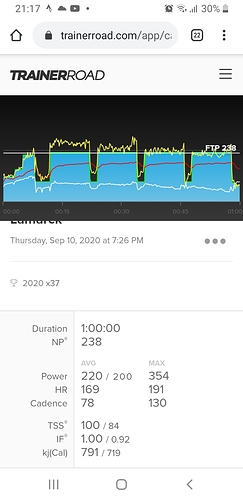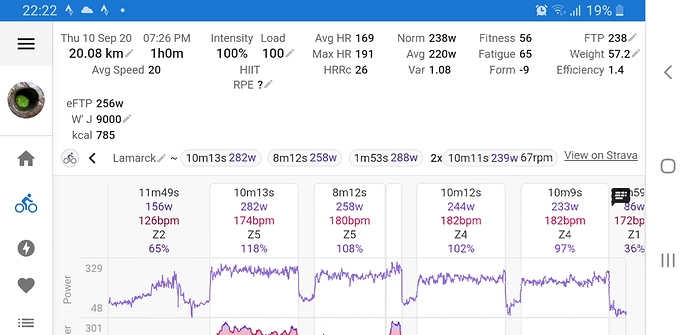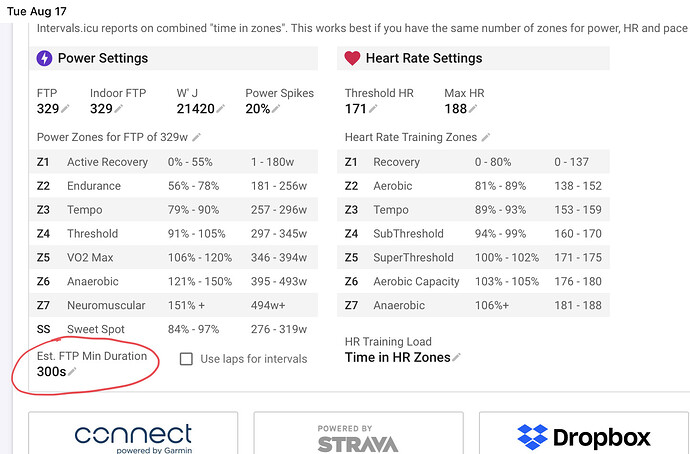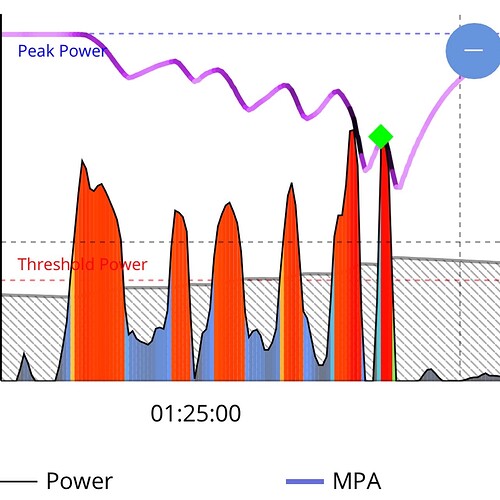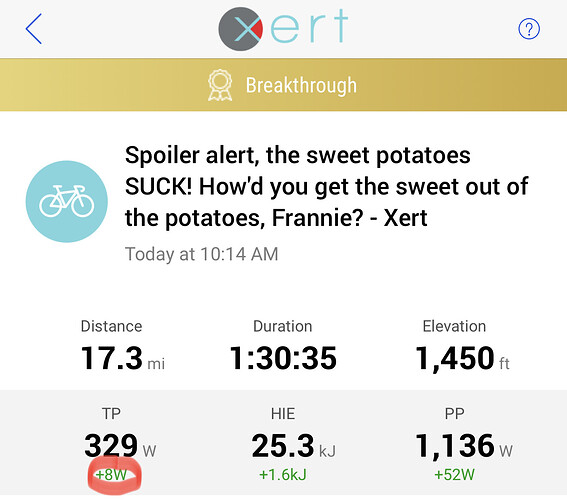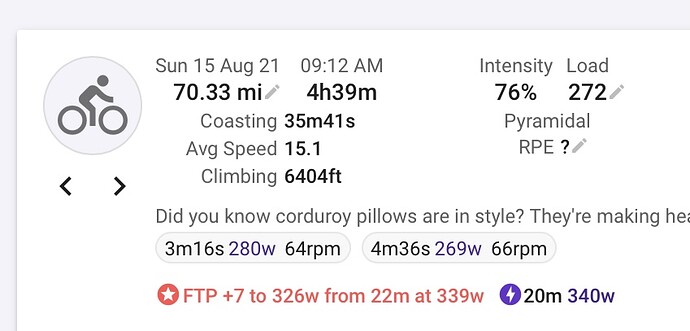I bombed my ramp test on Tuesday and got just 238w. On tonight’s session (albeit with ERG switched off) it was obvious that it was too low, my first 10min block was 283w and my 20min max (including a 2mins 50% recovery) was 262w which calculates (@95%) an FTP of 249w. Intervals.icu however calculates an e’FTP of 256w is that an accurate enough number to train off ?
Thats within 3% so it’s close enough IMO. This FTP business is pretty fuzzy. I think you just have to try it and see if you can get the workouts done.
Hello.
This regression analysis is’CP = eFTP’ (3 parameters between 3 and 15 min). Is that correct?
I think the order of the ordinary rider FTP number is as follows.
“Ramp test FTP> eFTP> 20 minute test FTP * 0.95> WKO mFTP> 1 hour test FTP”
In my opinion, according to statistical MLSS, the expected FTP should be less than the actual 30 minute peak power test.
For well trained riders with long MLSS this protocol may work well, but for less trained riders this eFTP is a very high setting.
Not quite. It uses a single max effort (of at least 3 mins configurable) to choose a predefined power curve modelled using Mortons 3P from lots of real world data. So if your max effort is 20m then it is likely to be very close to the 20m estimate but also works well if you only did 17m or 10m or whatever.
I think what you say about eFTP being a high setting for less trained riders is probably true. I hadn’t thought about it that way. So if you are just starting out a longer min estimation time is probably going to get you a better number.
Hi David
FTP is Fuzzy! That is the golden truth. Infact, we should term FTP as the Fuzzy Threshold Power. 
I think that my eFTP is estimated high, infact it is approaching or even exceeding the critical power I get off Golden Cheetah from the extended CP model. I have a reason to believe this would be a very high intensity to train to and potentially not reflecting a long term somewhat submaximal steady state under CP. I’m not losing my sleep over it though, as I know the realistic value is. But just thought of sharing.
What is the estimation method used? Could you please link to the basis ?
Hello,
don’t be too focused on the fuzzy concept of FTP. It can be fun (or not) to follow ones fitness with a test you do on a regular basis but at the end of the day there is no magic number or golden rule in the area of FTP or critical power.
What is your goal as an athlete ?
For what training do you need a precise FTP number ?
Lots of excellent coaches don’t even prescribe training with power targets.
For the sake of curiosity, do you have a watch estimating FTP like a Garmin ?
It uses a bunch of predefined curves created using Mortons 3P model on real world power data. This is essentially a generalisation of the “95% of 20m” rule to any duration, though the curves are not all the same shape and there are different male and female sets. This is a robust way of getting FTP (or CP) from a single effort.
W’ is estimated by finding the point on the athletes actual power curve that has the most energy above FTP (should really be CP but it doesn’t make much difference and the W’bal chart is relative to FTP). pMax is the athletes actual pMax for the time period.
So eFTP, W’ and pMax then define the athletes curve for specifying workouts based on MMP and so on.
The “running” eFTP value displayed on activities also decays slowly if you reduce training. You can always read off a “no-decay” value for a given time period on the /power page (also W’ and pMax).
Hello,
just a little post to say that i.i eFTP is the same as training peaks gave me after a progressive ramp test to exhaustion. For me it’s quite close to power @ 4 mol/l of lactate and also close to a max power for one hour I have done this year (but I understand this workout this summer might be a bit far away from today)
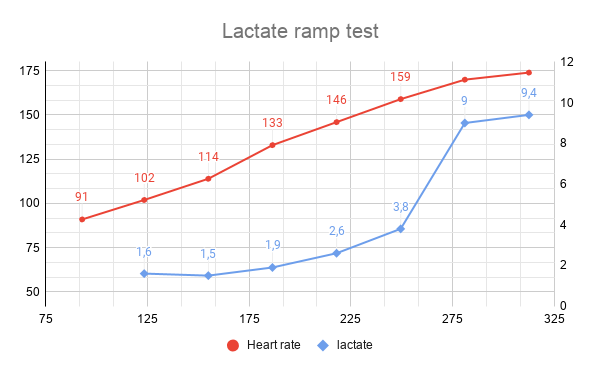
Hi @david, one small question: in your experience (or the community’s) how close is eFTP when its based on short efforts to real FTP?
I did an isolated hard effort of 3 minute duration and got this message for the ride:

I know at the top of my game my real FTP is not far off from this since I have a 1 hr power record of 275w, but is it advisable I anchor my training and training zones to this higher value?
Does eFTP take into account the rest of my recent power duration curve or just this isolated effort?
I apologise if all of this has already been discussed or explained. Thanks a lot in advance!
It depends on how good you are at short efforts. I have my min duration set to 5 minutes because I am good at short stuff:
The eFTP calc works off a single max effort, so the other stuff on your curve doesn’t count. Intervals.icu uses the short part of your power curve to estimate W’ relative to your eFTP. You could try bumping up the min duration and seeing what you get.
Following up on this topic more generally: If I put the eFTP and W’ from todays ride into the data for todays ride (uhm;-) then I get a W’bal value at the end of one (essentially the first) hill “climb” that’s very strongly negative, i.e., it goes to -9 (-9 kJ, I assume?).
Now. let me ay that I am new to power-based analysis. The pro side is that I have only four rides with powermeter data on i.icu and only one with data from Dropbox, so I could actually select that one ride for the overall power curve, which is used for eFTP & W’ calculation. I left it at the default model (max single effort Morton’s 3-P model). eFTP is estimated from a 7 min power value.
The con side is that I might be misunderstanding concepts or analysis and that I have fairly little data in the bucket for analysis…
Nevertheless, I though that W’bal cannot go negative, and when both eFTP and W’ come from the same fit to the data that then leads to the strong “overshoot” it seems, uh, inconsistent to me.
Am I wrong to begin with? Where?
Will this somehow level off with more data (I doubt it, but obviously ask because I don’t know)?
What other comments do you have – or what references for me to read?
Hi David! Where would on the Intervals site would I go to change the min duration. My eFTP is way high - it’s closer to my 5 min number from what I can tell. That might be fun to work towards but I’d rather have a number that’s closer to my actual 20 min number. If you can point me in the right direction, that would be most appreciated  Thank-you!
Thank-you!
I’m constantly comparing the eFTP here with the modeled number from Xert and there’s a very good correlation (the Full Frontal test in Suffer Fest also gave me very consistent results with eFTP)
Last week I did some hard efforts in the 30s range with breakthrough, and Xert bumped me up to 329W.
Over the weekend did a longer ride with a 22m full on effort and while that did not trigger Xert (which was already updated) it did trigger eFTP update in Intervals. The two numbers are scarily close (326W vs 329W)
I guess if I had updated my minimum interval for eFTP to under 30s it would have updated on Friday short intervals…
Intervals.icu looks for max efforts that are long enough to get eFTP (you can set what long enough is in /settings, default is 5 minutes I think). Once it has eFTP it uses your shorter max efforts to estimate W’ by looking for the most energy above eFTP on your power curve.
It only bumps up the “rolling” eFTP number when you get a higher number for a ride and it decays slowly if you reduce training volume. W’ is left alone and you need to capture it from the numbers displayed under your power curve. I have a todo list item to make that automatically updated like eFTP.
Thanks @david for the explanation.
Guess I was unclear. I took the eFTP and W‘ from a power curve that only included yesterday’s ride — by filtering on source „Dropbox“, which then resulted in only that one ride.
(If I would remove the filter, eFTP would be the same and W‘ would be even larger.)
The I put these numbers into the FTP and W‘ fields of that same ride; as you said eFTP was updated already.
In fact, I rounded FTP up from eFTP = 279 W to FTP = 280 W and W‘ down from 20.5 to 20 kJ.
Now, if I look at the W‘bal for that very same ride it goes down to -9 (kJ?).
That seems very inconsistent to me:-o
Technically W’ can go negative but that’s probably not the case in this instance. If you’re able to go negative in W’ then one of the parameters isn’t correct. I’m not sure what @David would advise - but in the past I’ve just bumped my W’ to a value that doesn’t go negative for that ride. After a while it stabilises with a range of efforts. Or you can do a full suite of tests in a day or 2. There are different ways of doing this:
-
CP3 test. warmup, maximum sprint effort, then hold it for 3 minutes. No looking at numbers or time. Helps to have someone shout at you. Have a bucket ready, and repeat after a rest to get valid numbers. Final 60s is you threshold power, total work above threshold is W’.
-
a more civilised approach is to do maximum efforts for 5s, 15s, 1min, 5min, and 20min in 1 or two rides with rest between. There are various protocols if you have a look for them.
Thanks for the feedback @John_Nye !
Now, I understand that these numbers might not reflect me as an athlete very well yet. In fact, from the rides and such I believe that my FTP is higher than what was shown in the few recorded rides so far. That could of course be part of the issue I am seeing…
However, I am wondering whether it is normal to be technically so inconsistent that the numbers from a single ride do not describe that same single ride “reasonably well”, at least not for W’bal…
Sports Science is more sports guesses. i.e. If we do x to someone in the lab what changes in output do we see and then what can we infer about the mechanisms that drive those changes.
W’ is a perfect example of that - it’s not really the truth about your ability to do work. It’s a suggestion about what might be happening. Even within the concept of W’ there are different mathematical models of judging recovery. Which one is right? We can design an experiment to see when you stop peddling and infer that this is 0 for W’. Fueling, hydration, mood, caffeine intake, music, being shouted and the gender of the person shouting at you to not stop peddling all influence the performance. So we don’t really know.
I like CP/W’ as a concept, I find them helpful for modelling solo events to come up with a plan. I also use it in bunch racing to check if I should be making a big effort or need a bit of time in the wheels - but you can’t race on a single metric. If the race is on - you have to do what you can do irrespective of a metric.
Some platforms put a lot of emphasis on this single metric - some don’t acknowledge it’s existence. Intervals makes (IMHO) a good set of compromises with it - but I wouldn’t worry too much about it from single rides.
There is a differential and an integral model for W’ where the differential model is recovering much faster but has a lower max value. The Integral model will rather under-estimate W’ for repeated shorter efforts and align better with longer efforts. The differential model is opposite and will in most cases underestimate single longer efforts. There is a deeper discussion about it here:
https://markliversedge.blogspot.com/2014/07/wbal-its-implementation-and-optimisation.html
Anyway, it will never be spot-on. But it helps to design more or less accurate HIT intervals.
Once you realize the above and the fact that your FTP differs from day to day, it’s easier to understand the sometimes big errors in W’.
